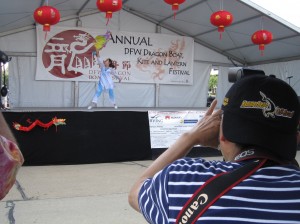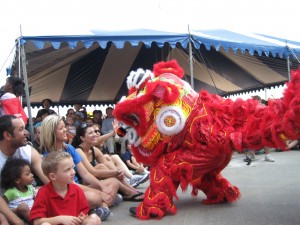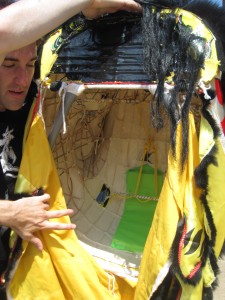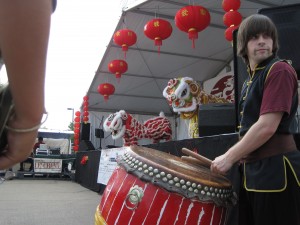Story by Daphne Chen
Video by Jacob Harpel and Kyle Kirby
Photo Gallery by Daphne Chen
On Sunday, May 16, Irving residents may have heard the sound of beating drums, the smell of fresh pad thai and the cheers of Dallas residents watching dragon boat teams race across Lake Carolyn in Las Colinas.
Behind the scenes of the fourth annual DFW Dragon Boat Festival, however, were performers and volunteers who often had been there since early in the morning, making sure the event went smoothly.
The event kicked off early in the morning with several musical and cultural performances, such as Emily Lo of Plano Shepton High School, who not only played on the 21-string Chinese harp but also performed a classical Chinese “calligraphy dance”.

“The way I use my fan and move imitates calligraphy,” Lo explained. “I first got interested in Chinese dance because I always admired the grace of the choreography. When I saw it performed for the first time, I was stunned.”
Lo and her parents stressed the importance of staying connected to her Chinese heritage.
“If you lose your culture, you lose your identity,” Lo said.
Dragon boat races took off throughout the day, with 36 teams competing (the Irving Fire was the frontrunner and has been the winner for every single festival). However, running the event from behind the scenes were the various volunteers from across the Metroplex. University of Texas at Dallas students and Adil Shaikh, a 2008 CHS graduate, and Shirley Wu had been working the event since 6:30 a.m..
“It’s been a headache setting up booths, banners putting up tents, carrying around coolers and water and ice, especially because it was really muddy In the morning, but it’s been really fun meeting people,” Wu said. “I got to meet the mayor [Phil Dyer] of Plano.”
One performance that was very popular with the audience was the Lion Dance, performed by students at Lee’s White Leopard Kung Fu School. The lion dance is a traditional Chinese dance in which two people work as a pair underneath a lion costume to mimic the rhythmic movements of a lion, which is a guardian animal in China.
Alex Campolo and Adam Reed were two of the dancers; both are part of the two branches of martial arts schools in the Dallas area, Lee’s White Leopard Kung Fu in North Dallas and Wu Yi Shaolin Martial Arts center in Coppell at Belt Line and Macarthur.
“Lion dance is an integral part of doing kung fu,” Campolo said. “It builds a lot of the stance work needed for martial arts: arm strength, the leg stance work, the jumping ability, coordinating with a partner, knowing where you are in the air. It all translates into really good martial arts skills, so martial artists tend to be lion dancers too.”
In fact, Campolo, who lives in Colorado, had to rush to learn the choreography for the lion dance performance due because one of the dancers was suddenly injured the day before. However, since he has been practicing martial arts for 21 years (“a senior student,” as Reed describes him), he was able to get up to speed quickly.
“The hardest thing is that you can’t see what’s going on, you can’t see a thing,” Campolo said. “When you see lions that are in sync with other lions, it means they practiced a lot with each other because they know each other’s rhythms.”
In addition, lion dancers have to deal with many different handles and grips inside the lion costume, between the pole that holds the weight of the lion, hand pieces to move the mouth, and a string apparatus to move the ears and eyes.

“Coordinating all that while you’re doing the movements, remembering to reach up and blink the eyes once in a while and making it look like a living thing is kind of the art form of it,” Campolo said.
Despite the difficulties of this traditional dance, Campolo and Reed still enjoy performing it, as is tradition before a martial arts demonstration in order to bless the demonstration.
Reed, Campolo’s partner in the lion dance, has been practicing martial arts for seven years.
“It definitely adds a different aspect to the martial arts,” Reed said. “The lion dance makes it into a team sport; as we’re training together, it brings people together through the rhythm of the entire team, not just the person under the cape with you. If one person is off then it looks like the whole team is off, so you really have to be together.”
Eric Emerts, who has been practicing martial arts on and off for about 10 years, played the drum while the lion dancers performed.
“We have a set routine,” Emerts said.
“But we rarely follow it,” Campolo interjects as everyone laughs in agreement.“What you practice and what happens on stage are very different. You’re blind and it’s hot, and you slip, and…”
Emerts’ powerful beats provide the background music for the lion dancers and infuse the performance with drama and energy.
“The drums, the music is just supposed to be there to make sure it sounds lively and there’s tons of energy in it,” Emerts said. “Basically I just watch them, and as soon as they start moving I’ll watch their cue and that’s when I change their beats.”
Different beats are specific to each movement, so Emerts is constantly on his toes during the lion dance.

“Watching them is really the hardest part, to get the right beat and the right time,” he said. “I’ll start a beat, and they won’t be doing what I want them to do so I’ll have to change the beat and go with that, without it sounding like I did the wrong thing or something.”
In the end, all six lion dancers plus the two drummers worked together to put on a riveting lion dance performance to kick off the dragon boat event.
“Lion dance, even though it’s always fun, it’s always a tremendous amount of work,” Campolo said. “You never get good enough at lion dance so it’s easy – you’re always tired and exhausted at the end of it. It’s really a labor of love.”








